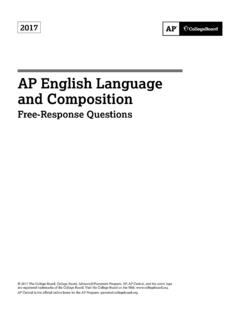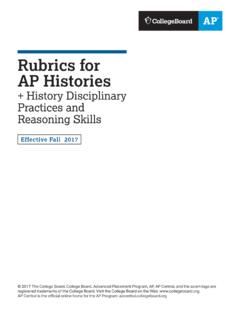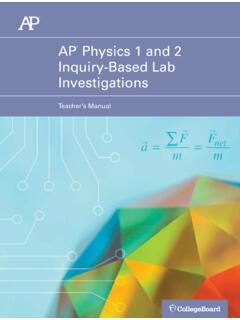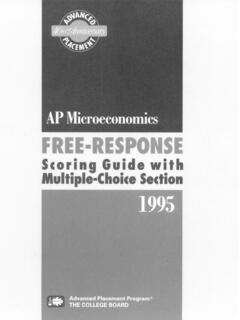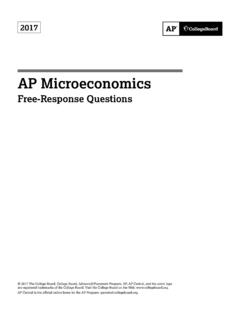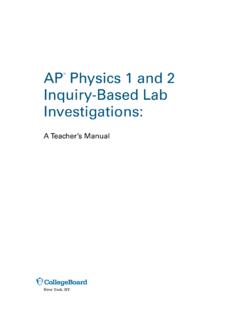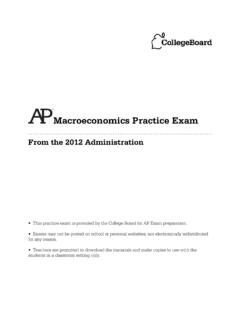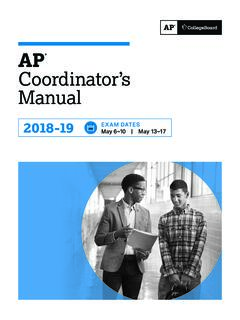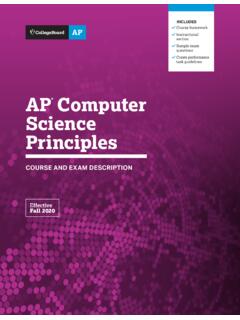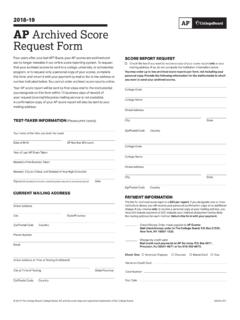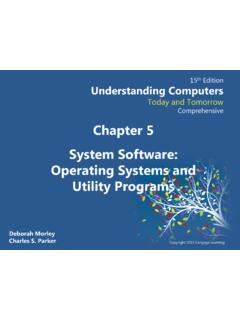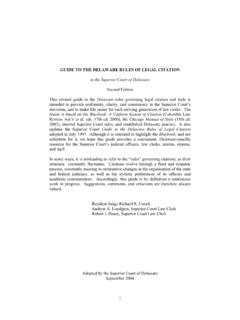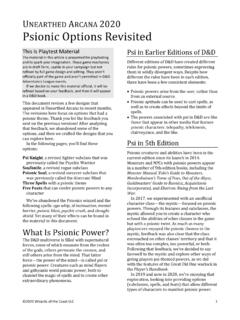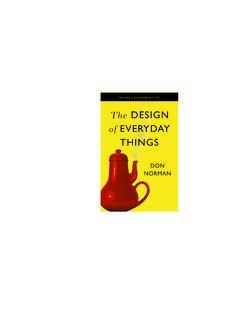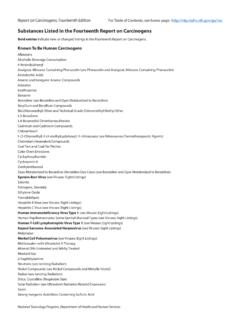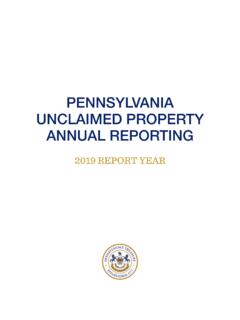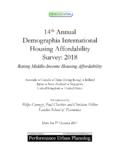Transcription of AP U.S. History - AP Central
1 INCLUDES Course framework Instructional section Sample exam questionsAP HistoryCOURSE AND EXAM DESCRIPTIONE ffective Fall 2020AP COURSE AND EXAM DESCRIPTIONS ARE UPDATED PERIODICALLYP lease visit AP Central ( ) to determine whether a more recent course and exam description is Fall 2020AP HistoryCOURSE AND EXAM DESCRIPTIONA bout College BoardCollege Board is a mission-driven not-for-profit organization that connects students to college success and opportunity. Founded in 1900, College Board was created to expand access to higher education. Today, the membership association is made up of over 6,000 of the world s leading educational institutions and is dedicated to promoting excellence and equity in education. Each year, College Board helps more than seven million students prepare for a successful transition to college through programs and services in college readiness and college success including the SAT and the Advanced Placement Program.
2 The organization also serves the education community through research and advocacy on behalf of students, educators, and further information, visit Equity and Access PolicyCollege Board strongly encourages educators to make equitable access a guiding principle for their AP programs by giving all willing and academically prepared students the opportunity to participate in AP. We encourage the elimination of barriers that restrict access to AP for students from ethnic, racial, and socioeconomic groups that have been traditionally underrepresented. Schools should make every effort to ensure their AP classes reflect the diversity of their student population. College Board also believes that all students should have access to academically challenging coursework before they enroll in AP classes, which can prepare them for AP success. It is only through a commitment to equitable preparation and access that true equity and excellence can be : Sonny Mui and Bill Tully 2020 College Board.
3 College Board, Advanced Placement, AP, AP Central , and the acorn logo are registered trademarks of College Board. All other products and services may be trademarks of their respective College Board on the web: v Acknowledgments 1 About AP 4 AP Resources and Supports 6 Instructional Model 7 About the AP History Course 7 College Course Equivalent 7 PrerequisitesCOURSE FRAMEWORK 11 Introduction 11 The Founding Documents 13 Course Framework Components 15 Historical Thinking Skills and Reasoning Processes 19 Course Content 24 Course at a Glance 29 Unit Guides 31 Using the Unit Guides 33 UNIT 1 Period 1: 1491 1607 47 UNIT 2 Period 2: 1607 1754 65 UNIT 3 Period 3: 1754 1800 89 UNIT 4 Period 4: 1800 1848 111 UNIT 5 Period 5: 1844 1877 131 UNIT 6 Period 6: 1865 1898 153 UNIT 7 Period 7: 1890 1945 177 UNIT 8 Period 8: 1945 1980 203 UNIT 9 Period 9.
4 1980 PresentINSTRUCTIONAL APPROACHES 219 Selecting and Using Course Materials 221 Instructional Strategies 226 Developing Historical Thinking Skills 236 Developing the Reasoning ProcessesEXAM INFORMATION 241 Exam Overview 247 Sample Exam Questions 261 AP History RubricsSCORING GUIDELINES 265 Part B: Short-Answer Question with Secondary Source 266 General Scoring Notes 268 Document-Based Question 273 General Scoring Notes 274 Scoring Guidelines for Document-Based Question 281 Document SummariesAPPENDIX 291 AP History Concept OutlineAcknowledgmentsCollege Board would like to acknowledge the following individuals for their assistance with and contributions to the development of this course over the years. All individuals affiliations were current at the time of Anderson, University of Colorado Boulder, Boulder, COJuliana Barr, Duke University, Durham, NCJulie Bell, James Madison School, Houston, TXKevin Byrne, Gustavus Adolphus College, St.
5 Peter, MNChristopher Capozzola, Massachusetts Institute of Technology, Cambridge, MABillie Jean Clemens, Swain County High School, Bryson City, NCTed Dickson, Providence Day School, Charlotte, NCRosemary Ennis, Sycamore High School, Cincinnati, OHJason George, The Bryn Mawr School, Baltimore, MDGeri Hastings, Catonsville High School, Baltimore, MDChristine Heyrman, University of Delaware, Newark, DEJohn P. Irish, Carroll Senior High School, Southlake, TXKathleen Kean, Nicolet High School, Glendale, WIDavid Kennedy, Stanford University, Stanford, CAElizabeth Kessel, Anne Arundel Community College, Arnold, MDStuart Lade, Brainerd High School, Brainerd, MNEmma Lapsansky, Haverford College, Haverford, PAMary Lopez, Schaumburg High School, Schaumburg, ILMaria Montoya, New York University, New York, NYCassandra Osborne, Oak Ridge High School, Oak Ridge, TNE. Anthony Rotundo, Phillips Academy, Andover, MAJames Sabathne, Hononegah Community High School, Rockton, ILDaryl Michael Scott, Howard University, Washington, DCSuzanne Sinke, Florida State University, Tallahassee, FLTimothy Thurber, Virginia Commonwealth University, Richmond, VACollege Board StaffJohn C.
6 Baran Jr., Director, AP Instructional Design and PD Resource Development Cheryl Harmon, Senior Director, AP Instructional Design and PD Resource DevelopmentChad Hoge, Director, AP History Content DevelopmentDaniel McDonough, Senior Director, AP Content IntegrationAllison Milverton, Director, AP Curricular PublicationsAllison Thurber, Executive Director, AP Curriculum and AssessmentSPECIAL THANKSC hristopher Budano, Lawrence Charap, and John R. Williamson | vAP History Course and Exam DescriptionReturn to Table of Contents 2020 College BoardTHIS PAGE IS INTENTIONALLY LEFT APCollege Board s Advanced Placement Program (AP ) enables willing and academically prepared students to pursue college-level studies with the opportunity to earn college credit, advanced placement, or both while still in high school. Through AP courses in 38 subjects, each culminating in a challenging exam, students learn to think critically, construct solid arguments, and see many sides of an issue skills that prepare them for college and beyond.
7 Taking AP courses demonstrates to college admission officers that students have sought the most challenging curriculum available to them, and research indicates that students who score a 3 or higher on an AP Exam typically experience greater academic success in college and are more likely to earn a college degree than non-AP students. Each AP teacher s syllabus is evaluated and approved by faculty from some of the nation s leading colleges and universities, and AP Exams are developed and scored by college faculty and experienced AP teachers. Most four-year colleges and universities in the United States grant credit, advanced placement, or both on the basis of successful AP Exam scores; more than 3,300 institutions worldwide annually receive AP Course DevelopmentIn an ongoing effort to maintain alignment with best practices in college-level learning, AP courses and exams emphasize challenging, research-based curricula aligned with higher education teachers are responsible for designing their own curriculum for AP courses and selecting appropriate college-level readings, assignments, and resources.
8 This course and exam description presents the content and skills that are the focus of the corresponding college course and that appear on the AP Exam. It also organizes the content and skills into a series of units that represent a sequence found in widely adopted college textbooks and that many AP teachers have told us they follow in order to focus their instruction. The intention of this publication is to respect teachers time and expertise by providing a roadmap that they can modify and adapt to their local priorities and preferences. Moreover, by organizing the AP course content and skills into units, the AP Program is able to provide teachers and students with formative assessments Personal Progress Checks that teachers can assign throughout the year to measure students progress as they acquire content knowledge and develop Students: Equity and AccessCollege Board strongly encourages educators to make equitable access a guiding principle for their AP programs by giving all willing and academically prepared students the opportunity to participate in AP.
9 We encourage the elimination of barriers that restrict access to AP for students from ethnic, racial, and socioeconomic groups that have been traditionally underserved. College Board also believes that all students should have access to academically challenging coursework before they enroll in AP classes, which can prepare them for AP success. It is only through a commitment to equitable preparation and access that true equity and excellence can be AP Courses: The AP Course AuditThe AP Program unequivocally supports the principle that each school implements its own curriculum that will enable students to develop the content understandings and skills described in the course framework. While the unit sequence represented in this publication is optional, the AP Program does have a short list of curricular and resource requirements that must be fulfilled before a school can label a course Advanced Placement or AP. Schools wishing to offer AP courses must participate in the AP Course Audit, a process through which AP teachers course materials are reviewed by college faculty.
10 The AP Course Audit was created to provide teachers and administrators with clear guidelines on curricular and resource requirements for AP courses and to help colleges and universities validate courses marked AP on students transcripts. This process ensures that AP teachers courses meet or exceed the curricular and resource expectations that college and secondary school faculty have established for college-level courses. Return to Table of Contents 2020 College Board | 1AP History Course and Exam DescriptionThe AP Course Audit form is submitted by the AP teacher and the school principal (or designated administrator) to confirm awareness and understanding of the curricular and resource requirements. A syllabus or course outline, detailing how course requirements are met, is submitted by the AP teacher for review by college visit for more information to support the preparation and submission of materials for the AP Course the AP Program Is DevelopedThe scope of content for an AP course and exam is derived from an analysis of hundreds of syllabi and course offerings of colleges and universities.
